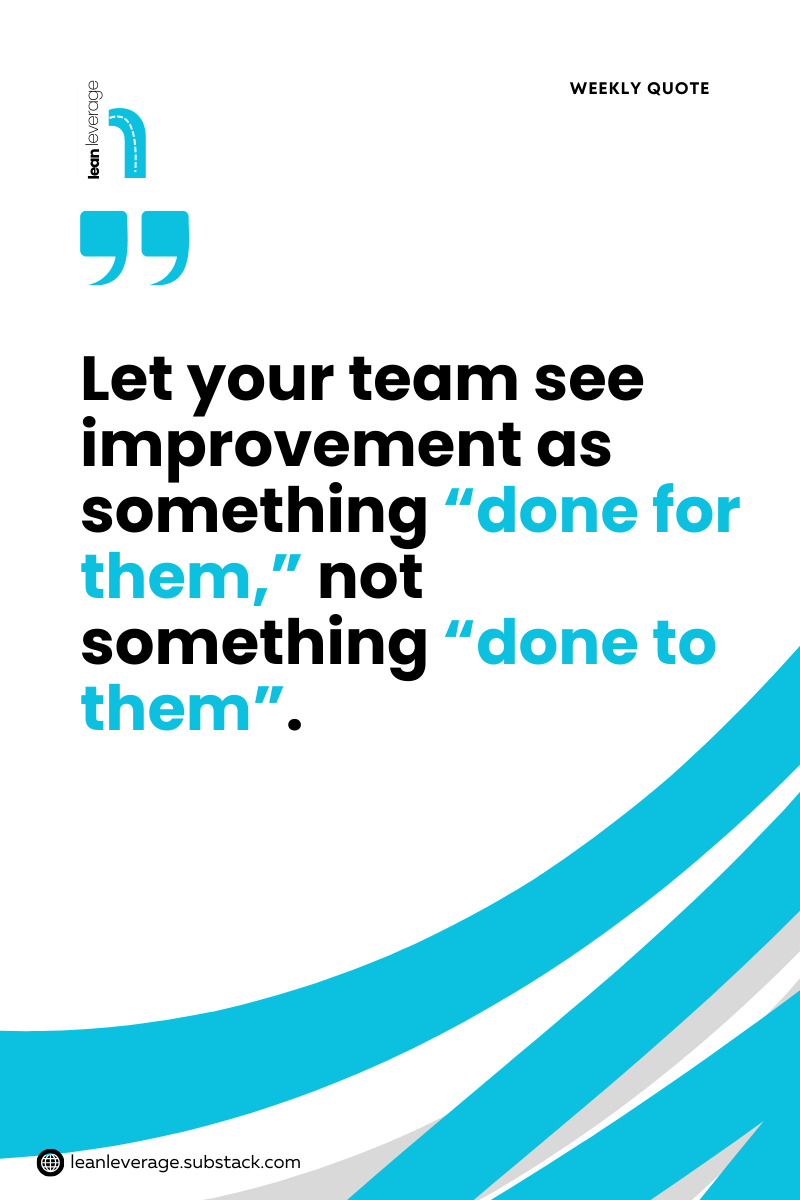Why Your Team Thinks Improvement Work Is “Extra Work".
The real job of a leader is not to bulldoze resistance. It’s to create the space, the clarity, and the trust that lets people catch up at their own pace.
Let me guess.
You’re a manager trying to make things better for your team.
You’ve seen the headaches, the delays, the endless rework, the same problems cropping up week after week. Then you hear about Continuous Improvement (CI) and how it can help the team find opportunities, solve problems, and generally make life less stressful. You’re excited. The team gets trained. They learn about data collection, PDSA, root cause analysis, process mapping and everything. People nod along, they even say they “can’t wait to get started.”
Fast forward a few weeks:
You suggest a 15-minute huddle every week to share improvement ideas.
Suddenly, nobody has time.
Huddles? “We’re too busy.”
Process mapping? “Maybe next month.”
PDSA cycles? “What’s that again?”
And just like that, the initiative dies before it even starts.
You’re there wondering, “Why do these people hate progress so much?”
The thing is, they don’t.
Nobody wakes up in the morning saying, “Oh, how I love chaos; let’s stay inefficient forever.”
Now, if your team actually does this, that’s a spiritual matter.
Skip the newsletter and call for deliverance.
The problem? Perception.
They just do not see improvement the way you do.
The Perception Problem
From where your team sits, CI looks like “extra work.”
Why?
They don’t see what’s in it for them.
They’ve survived without it for years. So naturally, they ask, “Why now?”
It feels like a “corporate initiative”, not something that will make their day-to-day life easier.
Think about the average team member. They’re juggling their core tasks, firefighting the latest “urgent” issue, and sitting in meetings that could have been emails.
Then a leader walks in and says,
“Great news! There’s a smarter way to work.”
Now, some people hear that and think,
“Oh, so we’ve been doing it the dumb way all this time? Wow, thanks for letting us know.”
What You Can Do Differently
If you want your team to embrace improvement, you’ve got to flip the script.
1. Start with pain points, not processes
Don’t start the conversation with Lean tools or a fancy A3 template.
Start with questions like:
“What frustrates you most in your day?”
“What takes up most of your time every morning?”
“If you could wave a magic wand and fix one thing in this process, what would it be?”
When you lead with their pain points, they would start to see improvement as something “done for them,” not something “done to them”.
Read that again if you have to.
2. Show small wins early
We are all wired to respond to progress. You do not have to wait for a “big reveal” to celebrate your quick wins. It does not have to be “perfect” to be communicated with the team.
Did you remove one unnecessary step from a report that saves someone 10 minutes a day? Share it.
Did a nurse create a visual reminder that cut down on medication errors? Celebrate it in your huddles. Bring cake if you have to.
Nothing kills scepticism faster than quick wins people can actually see.
3. Cut before you add
This one is huge and probably the most ignored. If you introduce a new task, remove an old one. Otherwise, your team just feels like you’re stacking bricks on an already wobbly load.
For example, imagine you’re rolling out a new digital dashboard to track performance. If the team still has to fill out the old paper form manually, they will hate you (and your dashboard) forever.
Here’s the rule:
Every new step = one old step gone.
Introduce a 15-minute huddle? Cancel a less useful weekly meeting that covers the same thing.
I once worked with a back-office team that started daily huddles. Initially, they hated it. Why? Because we didn’t remove the hour-long weekly call that covered the same information. The minute we cut that meeting, they loved the huddles, and engagement went up.
Moral of the story? People don’t resist change; they resist overload.
4. Involve, don’t impose
Nobody likes an ITK leader who shows up with a “finished” solution and says, “Here, do this.”
If your team feels like passengers in a process that affects them daily, don’t be shocked when they drag their feet.
Instead, co-create the solution. Ask for feedback, run small tests, and let the team tweak the approach.
It’s hard to resent something you helped create.
Get the team involved in spotting waste and co-creating solutions. Ownership changes everything.
Wrapping Up
Change isn’t a ready-made meal that you toss in the microwave, press “start,” wait two minutes, and expect everyone to be on board. Some people will get it right away, others will need to watch, question, and maybe even sulk a bit before they join in, and that’s okay.
The real job of a leader is not to bulldoze resistance. It’s to create the space, the clarity, and the trust that lets people catch up at their own pace. If you involve instead of impose, if you show quick wins, if you cut before you add, over time, adoption would start to feel like a partnership.
Good things take time, and in continuous improvement, the leaders who understand that, the ones patient enough to plant, water, and wait are the ones who build systems that don’t just change, but last.
Tomiwa Femi-Philips
Process Improvement Enthusiast




